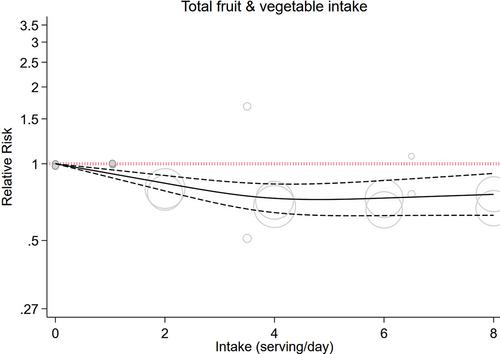下载PDF
{"title":"水果和蔬菜摄入量与骨折风险:建议、评估、发展和评价分级(GRADE)评估的系统性综述和剂量反应元分析","authors":"Sheida Zeraattalab-Motlagh, Seyed Mojtaba Ghoreishy, Arman Arab, Sara Mahmoodi, Amirhossein Hemmati, Hamed Mohammadi","doi":"10.1002/jbm4.10840","DOIUrl":null,"url":null,"abstract":"<p>Researchers have examined the link between consuming fruit and vegetables and the incidence of fractures for many years. Nevertheless, their findings have been unclear. Furthermore, the dose-dependent relationship has not been examined, and the level of certainty in the evidence was not evaluated. We carried out a dose-dependent meta-analysis examining the relation between fruit and vegetables intake and fracture incidence. PubMed, Web of Sciences, and Scopus were searched until April 2023 for cohort studies evaluating the relation between fruit and vegetables and fracture incidence. Summary relative risks (RRs) were computed from complied data by applying random effects analysis. To examine the level of evidence, we utilized the approach called the Grading of Recommendations, Assessment, Development, and Evaluations (GRADE). Ten cohort studies comprising 511,716 individuals were entered. There was a nonsignificant relation between fruit and vegetables, as well as only fruit intake and any fracture risk. In contrast, high versus low analysis presented that vegetables consumption was linked to a 16% decrease in any type of fracture incidence (RR 0.84; 95% confidence interval [CI], 0.75 to 0.95; <i>I</i><sup>2</sup> = 83.1%; <i>n</i> = 6). Also, per one serving/day (200 g/day) increments in vegetables consumption, there was a 14% decline in the fracture risk (RR 0.86; 95% CI, 0.77 to 0.97; <i>I</i><sup>2</sup> = 84.7%; <i>n</i> = 5; GRADE = moderate). With moderate certainty, a greater consumption of only vegetables, but not total fruit and vegetables or only fruit, might reduce the risk of fracture. These associations were also evident in dose–response analysis. Large intervention trials are demanded to approve our findings. © 2023 The Authors. <i>JBMR Plus</i> published by Wiley Periodicals LLC on behalf of American Society for Bone and Mineral Research.</p>","PeriodicalId":14611,"journal":{"name":"JBMR Plus","volume":"7 12","pages":""},"PeriodicalIF":3.4000,"publicationDate":"2023-11-10","publicationTypes":"Journal Article","fieldsOfStudy":null,"isOpenAccess":false,"openAccessPdf":"https://asbmr.onlinelibrary.wiley.com/doi/epdf/10.1002/jbm4.10840","citationCount":"0","resultStr":"{\"title\":\"Fruit and Vegetable Consumption and the Risk of Bone Fracture: A Grading of Recommendations, Assessment, Development, and Evaluations (GRADE)-Assessed Systematic Review and Dose–Response Meta-Analysis\",\"authors\":\"Sheida Zeraattalab-Motlagh, Seyed Mojtaba Ghoreishy, Arman Arab, Sara Mahmoodi, Amirhossein Hemmati, Hamed Mohammadi\",\"doi\":\"10.1002/jbm4.10840\",\"DOIUrl\":null,\"url\":null,\"abstract\":\"<p>Researchers have examined the link between consuming fruit and vegetables and the incidence of fractures for many years. Nevertheless, their findings have been unclear. Furthermore, the dose-dependent relationship has not been examined, and the level of certainty in the evidence was not evaluated. We carried out a dose-dependent meta-analysis examining the relation between fruit and vegetables intake and fracture incidence. PubMed, Web of Sciences, and Scopus were searched until April 2023 for cohort studies evaluating the relation between fruit and vegetables and fracture incidence. Summary relative risks (RRs) were computed from complied data by applying random effects analysis. To examine the level of evidence, we utilized the approach called the Grading of Recommendations, Assessment, Development, and Evaluations (GRADE). Ten cohort studies comprising 511,716 individuals were entered. There was a nonsignificant relation between fruit and vegetables, as well as only fruit intake and any fracture risk. In contrast, high versus low analysis presented that vegetables consumption was linked to a 16% decrease in any type of fracture incidence (RR 0.84; 95% confidence interval [CI], 0.75 to 0.95; <i>I</i><sup>2</sup> = 83.1%; <i>n</i> = 6). Also, per one serving/day (200 g/day) increments in vegetables consumption, there was a 14% decline in the fracture risk (RR 0.86; 95% CI, 0.77 to 0.97; <i>I</i><sup>2</sup> = 84.7%; <i>n</i> = 5; GRADE = moderate). With moderate certainty, a greater consumption of only vegetables, but not total fruit and vegetables or only fruit, might reduce the risk of fracture. These associations were also evident in dose–response analysis. Large intervention trials are demanded to approve our findings. © 2023 The Authors. <i>JBMR Plus</i> published by Wiley Periodicals LLC on behalf of American Society for Bone and Mineral Research.</p>\",\"PeriodicalId\":14611,\"journal\":{\"name\":\"JBMR Plus\",\"volume\":\"7 12\",\"pages\":\"\"},\"PeriodicalIF\":3.4000,\"publicationDate\":\"2023-11-10\",\"publicationTypes\":\"Journal Article\",\"fieldsOfStudy\":null,\"isOpenAccess\":false,\"openAccessPdf\":\"https://asbmr.onlinelibrary.wiley.com/doi/epdf/10.1002/jbm4.10840\",\"citationCount\":\"0\",\"resultStr\":null,\"platform\":\"Semanticscholar\",\"paperid\":null,\"PeriodicalName\":\"JBMR Plus\",\"FirstCategoryId\":\"1085\",\"ListUrlMain\":\"https://onlinelibrary.wiley.com/doi/10.1002/jbm4.10840\",\"RegionNum\":0,\"RegionCategory\":null,\"ArticlePicture\":[],\"TitleCN\":null,\"AbstractTextCN\":null,\"PMCID\":null,\"EPubDate\":\"\",\"PubModel\":\"\",\"JCR\":\"Q2\",\"JCRName\":\"ENDOCRINOLOGY & METABOLISM\",\"Score\":null,\"Total\":0}","platform":"Semanticscholar","paperid":null,"PeriodicalName":"JBMR Plus","FirstCategoryId":"1085","ListUrlMain":"https://onlinelibrary.wiley.com/doi/10.1002/jbm4.10840","RegionNum":0,"RegionCategory":null,"ArticlePicture":[],"TitleCN":null,"AbstractTextCN":null,"PMCID":null,"EPubDate":"","PubModel":"","JCR":"Q2","JCRName":"ENDOCRINOLOGY & METABOLISM","Score":null,"Total":0}
引用次数: 0
引用
批量引用



